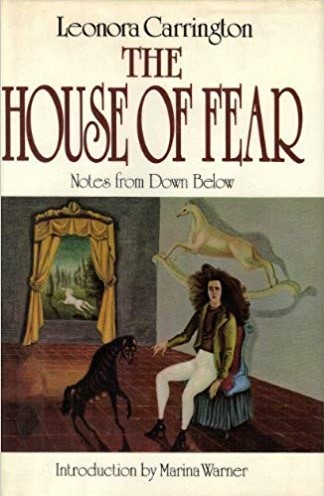 By LEONORA CARRINGTON (City Lights Books; 1988)
By LEONORA CARRINGTON (City Lights Books; 1988)
The late Leonora Carrington was a world-renowned painter and designer, and also one of the most interesting authors to emerge from the surrealist movement. The onetime wife of the famous surrealist artist Max Ernst—whose collage illustrations adorn the present volume—Carrington wrote wonderfully odd stories involving talking animals and otherworldly transformations, centered on obscure alchemical and mythological concepts. Even if such heady conceits are lost on the reader, her stories can still be enjoyed as straightforward exercises in black-humored surrealism.
Case in point: THE OVAL LADY, a short collection originally published in France back in 1939 (and in English, in a gorgeously designed trade paperback edition, in 1975). It contains six fairly representative stories, all related in Carrington’s customarily droll style (and ably translated by Katherine Talbot and Marina Werner). The standouts are “The Debutante,” in which a talking hyena convinces a girl to let it go to a dance in her place, wearing a face ripped from the head of the girl’s maid; “White Rabbits,” about a zombie woman who cares for her similarly afflicted husband; and “The Beloved,” featuring a man who uses his wife’s cadaver to incubate eggs.
The 1944 novella “Down Below” (also initially published in English in standalone form) is a change of pace, but only slightly: it’s the true story of Carrington’s descent into madness and her incarceration in a mental hospital. Although the events it describes all really happened, it reads like a surrealist nightmare in its harrowing barrage of ecstatic and nightmarish visions. In this psychoscape the “real” is indistinguishable from the hallucinatory, with Carrington desperate to escape her confinement in the asylum and move “Down Below,” her term for “the Earth, the Real World, Paradise, Eden, Jerusalem…I felt that, through the agency of the sun, I was an androgyne, the Moon, the Holy Ghost, a gypsy, an acrobat, Leonora Carrington, and a woman.” The novella overall makes for an ideal companion-piece to other quasi-fictional insane asylum memoirs like Sylvia Plath’s THE BELL JAR and Anna Kavan’s ASYLUM PIECE, yet I feel “Down Below” outdoes them both.
THE HOUSE OF FEAR contains the two works described above, as well as the title story, about a girl who attends a convention of talking horses, and the novella “Little Francis,” an autobiographical reverie about a young boy staying with his eccentric uncle. In the course of the story the uncle takes off and Little Francis grows a horse head (the autobiographical element is evinced by the fact that the tale is “really” about a summer Carrington spent with Ernst and his first wife).
But that’s not all you’ll find in this must-own volume: there’s a lengthy introduction by editor/translator Marina Warner detailing Carrington’s highly eccentric life and works, as well as a brief photo gallery showing that Carrington in her twenties (when she wrote “Down Below”) was an uncommonly good looking woman.
